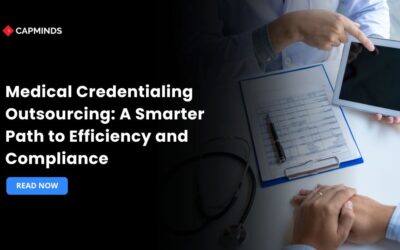How to Streamline Medical Credentialing and Avoid Costly Delays
Medical credentialing, the methodical mechanism of confirming the professional qualification of a healthcare provider, is one of the most important, yet frequently frustrating, administrative healthcare industry activities.
Although it does a critical duty in maintaining patient safety and regulatory compliance(important components of healthcare compliance and credentialing), slow or inaccurate credentialing processes may rapidly become a problem in terms of finances and operations.
Think of a highly recruited physician who has been sitting idle week after week, with no ability to see a patient and bill the service, simply because an application to have their provider enrolled and credentialed has entered an administrative bottleneck.
The financial and operational cost of the delays in credentialing results in loss of revenue and the pressure of an impending start date. Even a small obstacle in a high-volume healthcare business would equate to six figures of revenue that it would lose every year. This is the reason why the education on how to streamline the credentialing is not a luxury anymore but a necessity towards financial well-being.
What Is Medical Credentialing and Why Does It Matter?
Medical credentialing is the strict procedure that hospitals, health plans, and managed care organizations use to review and authenticate the background of a provider, including his or her education, training, licensure, and professional history.
This is required by the regulatory agencies and accrediting bodies, as well as the Joint Commission, so that all healthcare practitioners involved in treating patients are qualified and competent.
In addition to quality assurance, credentialing is the revenue cycle management entry point. The payers cannot entirely enroll in a provider step that is usually combined with the base medical credentialing process before his/her credentials are verified.
There will be denials in claims without adequate provider enrollment and credentialing, resulting in revenue backlogs and cash flow problems.
Common Causes Behind Credentialing Delays
The first step of acquiring knowledge of streamlining credentialing is understanding the common barriers. Numerous organizations endure recurrently the same range of problems:
- Paper-Based, Manual Processes – Data collection based on physical paperwork, faxes, and spreadsheets is, by its nature, slow and subject to human error, posing a substantial risk of prevalent credentialing errors.
- Decentralized Information – Provider data are frequently maintained in different systems such as HR files, hospital databases, and payer portals, and it can be hard to retrieve, update, and validate in a short period of time.
- Half-Baked or Bogus Applications – Providers with a multitude of administrative needs often file applications with unfinished signatures, addresses that are no longer up to date, or forgotten history. These typical credentialing errors require a tedious back-and-forth process.
- Slow Primary Source Verification – The longest delays in the process may be the ones caused by the timeliness of the responses of medical schools, residency programs, and licensing boards.
- Absence of Anticipatory Re-credentialing – Not initiating the re-credentialing process early enough before the expiry dates of licenses, certifications, and insurance cover.
How to Streamline the Credentialing Workflow
Automation of Provider Data Checking
Credentialing automation may dramatically accelerate the tedious process of primary source verification. The current credentialing systems are connected to the primary sources of data, such as the National Practitioner Data Bank (NPDB), the Office of Inspector General (OIG) exclusion list, and state licensing boards.
This integration can be used to do real-time checks immediately, and this saves the days or weeks that would have been wasted on waiting until physical correspondence is received. This digital handshake is the first step to streamline credentialing.
Centralized Credentialing Software
The most effective tool that can be used in the entire process is a centralized medical credentialing software system. This software makes a single source of truth for all data from providers.
Standardized Forms – The software may also pre-populate applications with already existing data, thereby making it consistent, and also the probability of making common credentialing errors is greatly reduced.
Document Management – DEA certificates, diplomas, insurance policies, and any other required documents are digitized and stored in a secure and easily accessible spot so that when an audit or re-credentialing is needed, the required documents are readily accessible.
Workflow Management – Automation of task assignment and tracking will ensure that there is no idle application. The system has the ability to send automated reminders to the credentialing team as well as the provider to push the application.
Creation of Real-Time Compliance Tracker
The implementation of effective healthcare compliance and credentialing needs to be continuously monitored, and not only once. An advanced centralized software will often include a real-time compliance tracker that constantly monitors critical dates and statuses.
This enables organizations to:
- Monitor license and certification expiration dates.
- Conduct or make ongoing sanctions and exclusion checks (OIG, SAM).
- Proactively start the re-credentialing process 90-120 days before expiration, which would remove the risk of the provider turning into non-compliant and unbillable.
Related: 10 Medical Credentialing Mistakes And How To Avoid Them
Compliance, Accuracy, and Speed: Find the Balance
Although speed is critical, it cannot be acquired at the cost of accuracy and healthcare compliance and credentialing.
All the data should be documented and verified by regulatory bodies. Credentialing automation assists in locating this balance by increasing the speed of verification and making it verifiable.
Automated systems provide comprehensive audit trails of each check done and demonstrate due diligence and fulfill regulatory demands.
The idea is to ensure that the correct and conforming decision is also the fastest. It is the ultimate challenge to any system that wants to streamline the process of provider enrollment and credentialing.
Key Metrics to Measure Credentialing Efficiency
|
Metric |
Target Goal |
Why It Matters |
|
Credentialing Cycle Time |
30-60 days Initial |
The total time from application submission to final approval; a direct measure of efficiency. |
|
First-Pass Acceptance Rate |
>95% |
Percentage of applications accepted without requiring corrections due to common credentialing mistakes. |
|
Payer Enrollment Lag |
<15 days Post-Credentialing |
Time between internal credentialing approval and final payer enrollment (a critical aspect of provider enrollment and credentialing). |
|
Days in Accounts Receivable (A/R) |
Lower is better |
Measures the impact of credentialing delays on your overall revenue cycle. |
CapMinds Medical Credentialing Services: Simplify and Strengthen Your Revenue Cycle
Delays in credentialing don’t just slow down operations; they stall your revenue. At CapMinds, we help healthcare organizations eliminate these barriers with end-to-end medical credentialing services designed for speed, accuracy, and compliance.
Our digital health tech solutions seamlessly integrate credentialing with your medical billing, coding, and revenue cycle management systems to ensure every provider is verified, enrolled, and ready to deliver care faster.
With CapMinds, you get:
- Automated Credentialing Workflow – Real-time data verification and compliance tracking.
- Revenue-Ready Provider Enrollment – Streamlined payer connections to minimize payment delays.
- Integrated Billing & RCM Services – Unified systems that enhance cash flow and reporting accuracy.
- Compliance-Driven Processes – Audit-ready documentation and regulatory adherence built in.
Partner with CapMinds to transform credentialing from an obstacle into an opportunity for growth and financial strength. Start your efficiency journey today.




